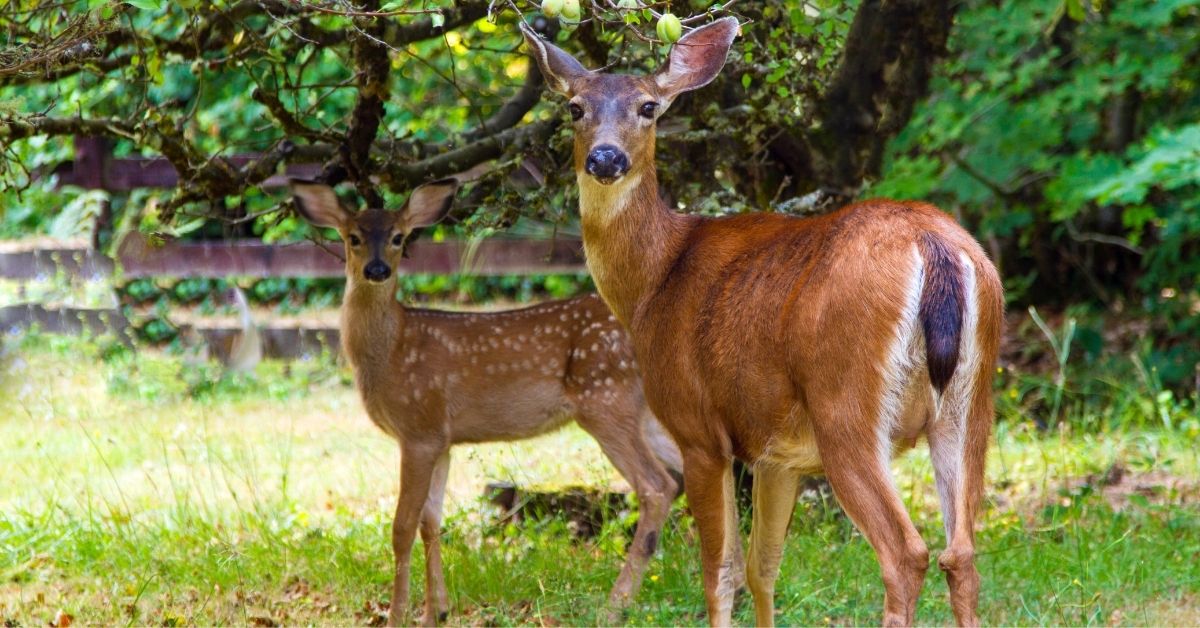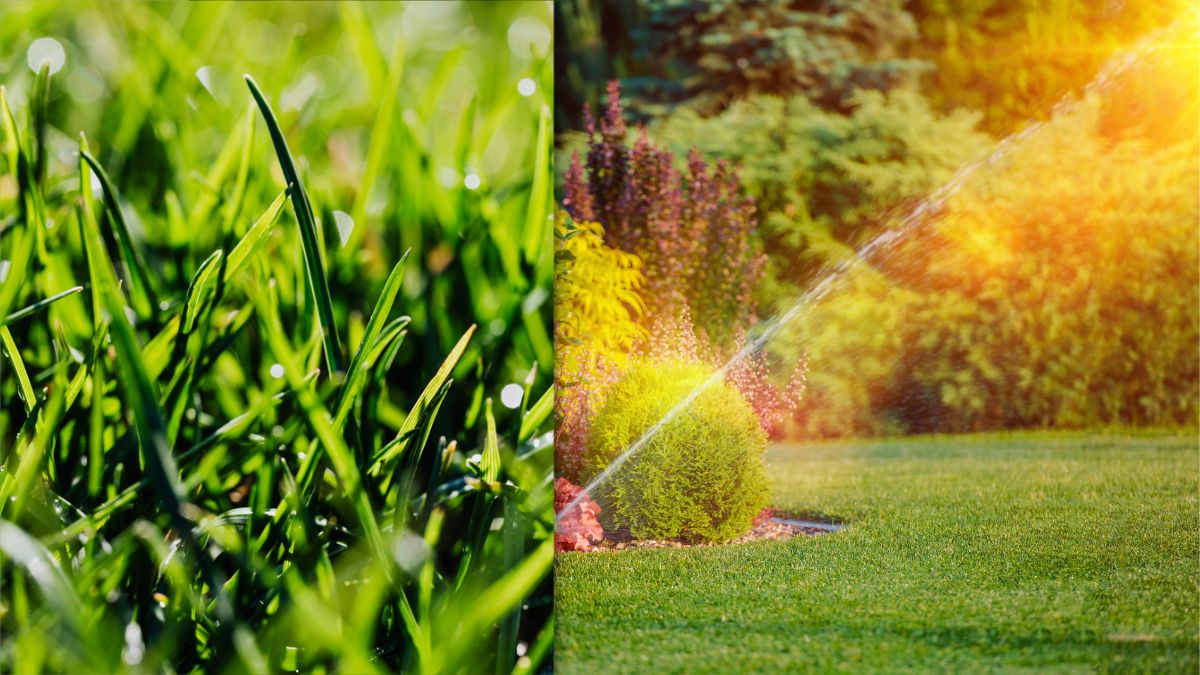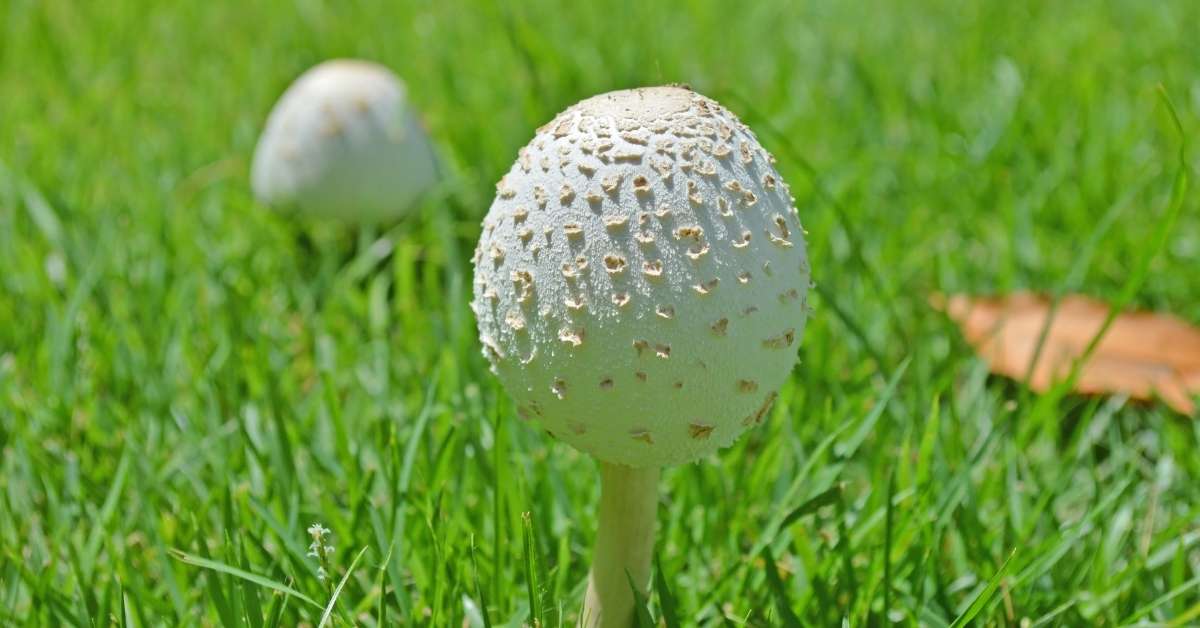Deer repellents, fences, and plant choices can all assist in keeping deer out of your garden. Deer are beautiful to watch, with their deep brown eyes and elegant movements, but when they get into your garden, they can cause a lot of damage in a short amount of time.
Deer damage plants in three ways;
- by browsing branches, leaves, and shoots,
- by rubbing their antlers against the bark;
- and by scraping the soil around trees and shrubs.
Deer in Yard: Gardening with Deer in Mind
Even if there are deer in the area, a knowledgeable gardener may have a thriving garden. You may reduce deer damage in your home landscape by selecting some plants over others and properly planting them.
A multi-pronged strategy is required to protect your garden. Following are a variety of techniques to consider. Here is one of the most detailed lists to successfully keep the deer out of your garden or yard.
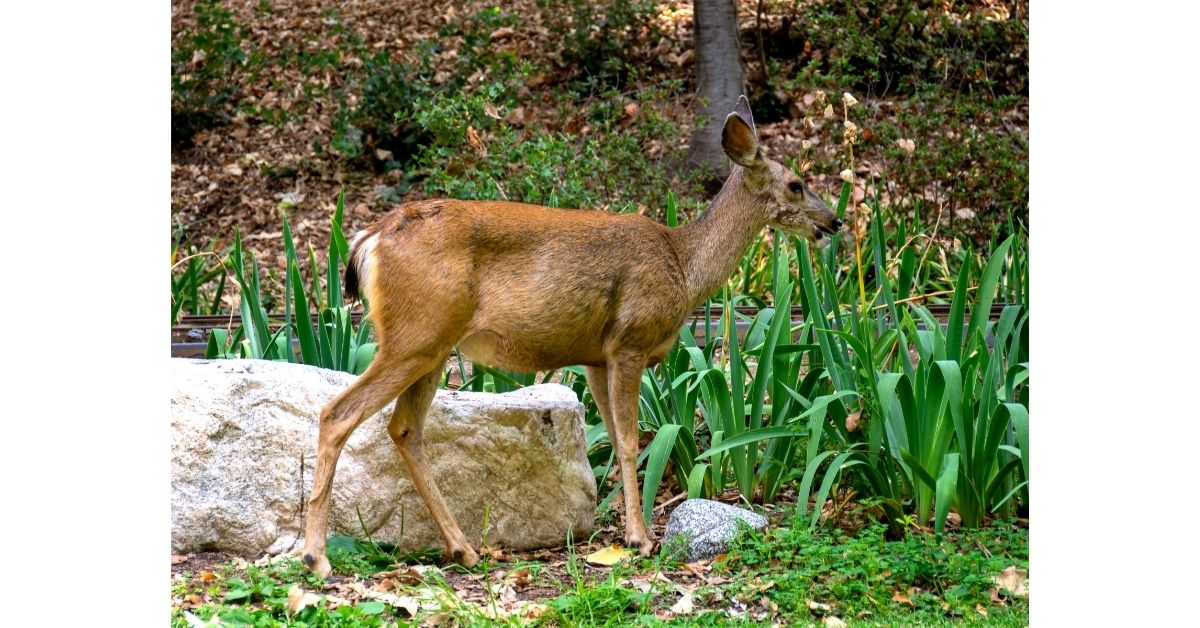
1. Sprays and Granulars to Keep Deer Off Your Property
When the deer population is low, there are alternative food sources for the deer, and your neighbors aren’t using repellents; these items function best. Deer cause the most damage during the winter months when other sources of food are short.
If you use these things before the deer begin to dine in your garden, the deer may seek food elsewhere. It will be more difficult to entice them away from your garden if they begin to browse there.
Deer are repelled by chemicals due to their odor or taste. Taste-based treatments are sprayed directly on the plants, whereas smell-based goods are administered to a group of plants rather than individual plants. Taste-based products should not be used on food crops since they come into direct touch with plant components and may be toxic.
There are hundreds of commercial items on the market, and new ones are introduced on a regular basis. What works in one geographic location may not work in another. A chemical that works in one season may not function all year; a deer repellent that works one year may not work the next. As a result, homeowners should not rely on a single product.
Not all commercially available items are equally efficient.
- Plantskydd,
- Hinder,
- Ro-pel,
- Ani-spray,
- Deer Away,
- Enviro Pro, and
- Liquid Fence
are just a few of the numerous products that have shown to be effective in various situations.
It is critical to read product labels and follow directions for safety and get the most out of repellents. When the temperature is over 40 degrees, and there is no breeze, apply. Most repellents must be reapplied on a regular basis.
2. Homemade Repellents To Repel Deer
Gardeners, homeowners, nursery owners, and even academics have tried repellents derived from common household items. Among the most common components are eggs, hair, spicy peppers, and soap.
There is no magic bullet, no universally successful DIY cure, as there is with all chemicals, homemade or not. The dishes that follow are straightforward to prepare. Various users claim to have had success with each of them at different times and under different conditions. The entire egg repellant, according to user feedback, maybe the most effective of the DIY recipes.
The only way to find out if these DIY remedies will work for you is to give them a go. (By the way, according to some experienced gardeners, deer are rarely deterred by coyote urine or blood meal -two popular homemade deterrents- while some other people strongly stick up for it.)
3. Using Coyote Urine to Protect Your Trees and Plants from Deer
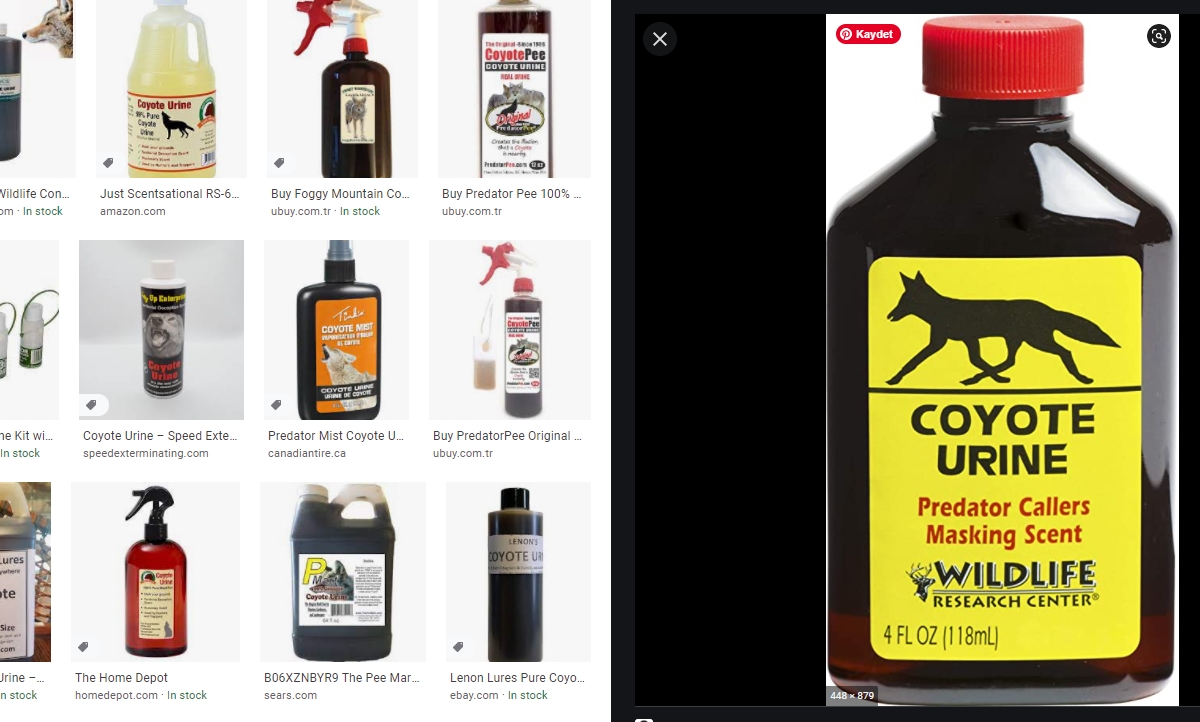
Although it may seem strange, for some people, using coyote urine as a deer repellent is one of the best and most natural techniques to keep deer out of your yard. This approach has several advantages, and it will surely keep all Deer out of your yard.
There are several applications for wild animal urine, and it is becoming increasingly popular for a variety of reasons. This product is also available in many formats in stores, but notably on the internet. You can choose which kind is appropriate for your property after understanding a little about the various types.
The idea of utilizing coyote urine as a deer repellant and for other purposes works because the fragrance is recognized by deer and other animals preyed upon by coyotes. Urine is sometimes the sole method for prey to detect the presence of a coyote.
They’ll want to stay away from your yard at all costs since they’ll think there are coyotes there! You won’t need to reapply it very often, even if it rains, because deer will most likely leave your home after smelling the urine around your yard a couple of times.
You might be curious as to how individuals collect coyote urine in order to utilize it as a deer deterrent. The solution is easy to understand. Zoo admission fees and other levies help pay for the care of animals in zoos and sanctuaries, and collecting their pee for profit is another method to pay for their food and lodging.
The pee used for selling is gathered from the ground, and since urine is sterile, there is no risk. However, if you come into contact with coyote urine, you should wash your hands immediately.
You must surround your property with coyote urine, either in liquid form or as a powder. You don’t need to mix the powder with water; instead, simply shake it on the lawn. At first, you’ll need to use it every two weeks or so, then every few months. After that, you should generally only use it if the deer appear to be returning.
If you’re using coyote urine as a deer repellent, it won’t wash away in mild rain, but if it rains heavily, you might want to reapply it.
Even though they don’t appear to be hazardous, deer are wild creatures that may be lethal if confronted. They consume vegetation and may wreak havoc on your yard. Predators may be attracted to your property as a result of them.
The best thing to do is just drive them away so that your dogs and garden are not disturbed. They may be a serious threat to youngsters playing in your yard; however, they will usually flee rather than attack a person. To be on the safe side, using coyote urine as a deer repellant is a good idea.
4. Whole Egg Repellent to keep deer out of your garden
In a blender, combine 2 whole eggs and 1 or 2 cups of water. Remove and discard the white membrane around the yolks before mixing to avoid clogging your sprayer.
Combine the ingredients in a gallon of water and spray on plants. During the season, reapply two or three times.
Warning: Do not use the egg repellent near the house because it has an awful smell.
5. Hot Pepper Repellent to keep deer out of your yard
In a food processor, liquefy three fresh spicy peppers (red cayenne, jalapeño, or habanero). Strain the liquid into a jar using cheesecloth (one quart or larger). 2 tbsp. vegetable oil, 1 tbsp. paper glue, 2 tbsp. liquid dishwashing soap To use, dilute one part concentrate with five parts water. Before using a sprayer, give the mixture a good shake. After rain or snow, or when new foliage sprouts, reapply.
Warning: Hot pepper recipes can be dangerous! Wear gloves and goggles when mixing and spraying to keep it off your skin and out of your eyes.
6. Tabasco repellent
Spray plants with a mixture of Tabasco sauce and water. This is a spicy pepper repellant with a twist.
7. Soap repellent
Put fragrant soap bars in nylon stockings or other mesh carriers. Tie the holders to shrubs or small trees. This is a repellant for a specific region; one bag covers around one square yard.
8. Hair bags to prevent deer from eating trees
Hair repellents are similar to soap repellents in that they are hung from trees. The most frequent hair used is human hair, although some individuals have had success using dog hair as well. Three feet apart, hang hair bags to keep the deers away from your yard.
9. Building Barriers, Fences or Deer netting for deer-resistant Gardens
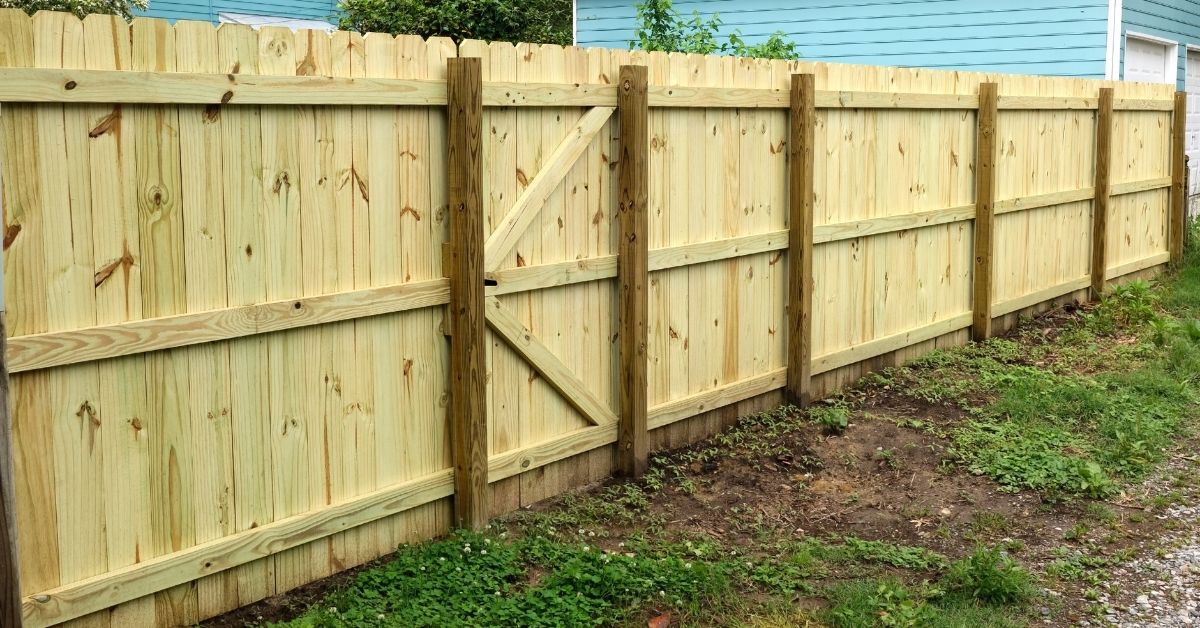
Only fences are guaranteed to keep deer out of a garden, and even they aren’t failsafe.
Installing some form of deer barrier was one of the most prevalent tactics employed by people in the past to protect a yard, garden, or farm from deer.
Our forebears were on to something by employing a more natural strategy to preserve their crops, and deer netting in this manner is incredibly cost-efficient, effective, and simple to install. Deer netting is still in use today, and it’s a cost-effective way to preserve our gardens and landscape.
Deer netting is available in a variety of heights and widths. However, you must consider the height of the net; if it is too little, a deer may be able to jump over it; if it is too large, it may be an eyesore. Deer netting, on the other hand, might rescue your valuable shrubs or plants from deer if you choose the proper one.
Some may argue that installing deer netting is difficult, but in my experience, deer netting can be installed with a few basic tools, time, and patience. First and foremost, you must identify the region where the netting will be erected. It should ideally be done to cover the target area’s parameter.
If you merely want to cover your garden area, you’ll need netting that’s the right height and length; if your deer netting isn’t long enough, it may cause breaks in the perimeter of the area you’re attempting to keep deer out of.
Installing deer netting and planting repellent plants can be an easy, practical, and cost-effective alternative for protecting your garden and decorative landscaping. Deer netting is a long-term solution to deer pest control; deer nets often endure for years before needing to be updated.
You may pick from a variety of options on the market. You may pick from a variety of patterns and colors. Some deer netting is U.V. resistant, and installing a deer net is simple if you already have fence posts in place. When properly built, deer nets should also provide protection from rabbits and other small animals.
10. Non-electric fences
Because deer dislike being trapped, a four-foot-high fence may be sufficient to keep them out of small gardens. The fence should be eight feet high for larger spaces. The barrier appears to be more effective when slanted outward.
Wire or plastic mesh fences are commonly used. Deer are warned of the barrier by streamers put four feet from the ground every twelve feet.
11. Electric fences
A single-strand electric fence may be sufficient for a home garden, although electric fences with five, seven, or nine wires are not uncommon. Baiting the fence with peanut butter draws the deer in, where they are given a corrective shock that may teach them to stay away.
12. Protectors
Protectors put around the trunks of tiny trees or shrubs may assist in keeping them from being browsed. Protectors should reach four to five feet up the trunks and be composed of woven wire, plastic tree wrap, or polypropylene.
13. Electronic Devices
Electronic devices use high-frequency sound waves, motion sensors, and other humane technologies to Keep deer out of gardens. With Yard Sentinel and similar electronic repellents, you can choose from a variety of methods to repel deer without disturbing your family and your neighbors.
Water sprinklers operate with timers or motion sensors to spray water on unsuspecting deer, making your garden an inhospitable place for browsing. DURANOM Ultrasonic Wild Animal Repeller and Orbit 62100 Yard Enforcer Motion-Activated Sprinkler are two popular high-velocity devices.
14. Scare Devices
Strobe lights, fireworks, sirens, loud music, and gas exploders may deter deer for a week or two to prevent them from eating your plants until they become accustomed to them. Scare devices will annoy people more than deer in urban and suburban areas.
Electronic Deer Repellent Pros And Cons
When deer are strolling through the woods, they appear to be lovely. When they arrive at your garden and kill your plants, flowers, and veggies, they aren’t so appealing. What previously appeared to be Bambi rapidly transforms into a dangerous beast. Rural deer habitats are being encroached on at an unprecedented rate, and an increasing deer population is exacerbating the situation.
Deer will eat anything that is classified as vegetative, yet a hungry deer will not be fussy. Deer may appear kind, yet they consume a lot. On average, an adult male deer consumes approximately five pounds of food each day. The easiest approach to keep deer out of the yard is to stop them in their tracks. If preemptive steps are adopted, the garden will not become the next deer salad bar.
Because it uses an electric shock, electronic deer repellant such as an electric fence is typically more successful than ordinary fencing. It works in general, but because of its height, it may be costly and an eyesore. Although an eight-foot-high fence is ideal, lesser fences can deter opportunistic eaters from feasting in the yard.
An interesting fact regarding electric fencing is that peanut butter can be smeared onto aluminum foil attached to the fence. The peanut butter serves as a potent lure, and deer will not come near it once they have taken a taste and been shocked. Havahart makes another effective electronic deer repellent that lures deer only to provide them with a 400-volt surprise.
Ultrasonic repellents emit noises that deer find intolerable and are often not heard by humans. Bird-X DG Deer Gard Ultrasonic Deer Repeller is one famous brand. It is D.C., or A.C. operated and featured an integrated motion sensor and adjustable frequency of both sonic and ultrasonic sound. In addition to keeping deer away, it deters other pests.
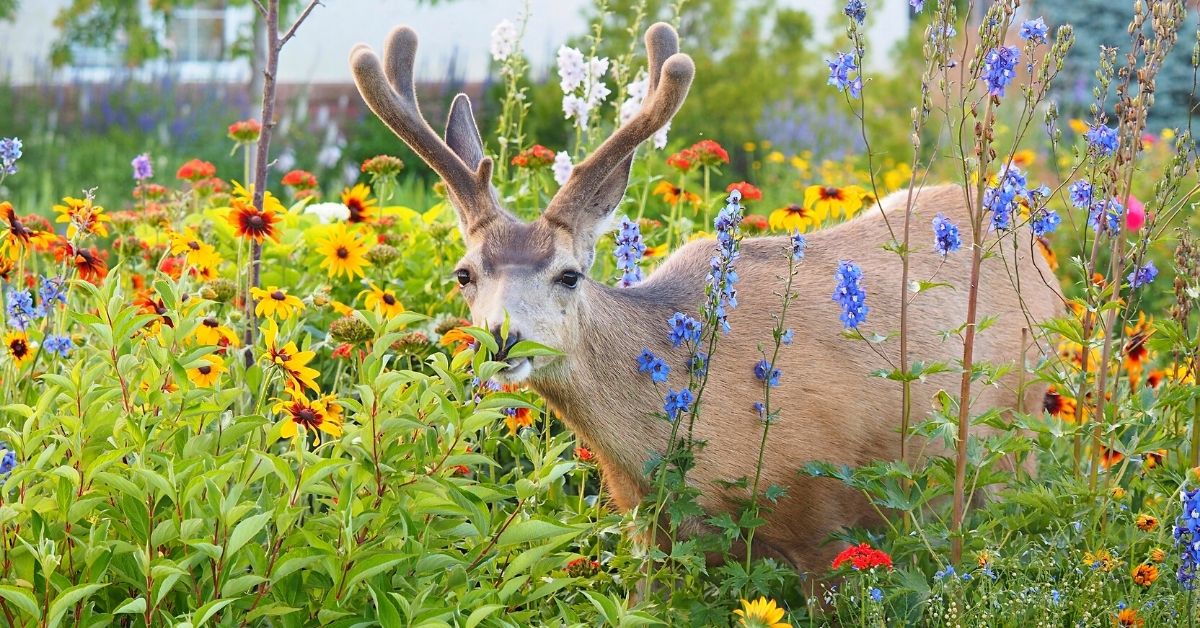
Benefits And Drawbacks Of Homemade Deer Repellent
When deer venture into a yard and find some plants to munch, they are likely to return. In some cases, this area will become the local hangout for the four-footed animals. Some people purchase a deer fence or commercial sprays to deter the creatures. The most diligent gardeners may choose to address the deer problem by making homemade deer repellent.
A commercial product can become an expensive repellent method if many plants need protection. Homeowners who make their deer repellent save money because many deer repellent recipes include household items on the ingredient list. Commercial products often contain chemicals, which can be unsafe for use on vegetables. These are not included in homemade recipes.
The need to mix the solution before each use is one of the main disadvantages of using a homemade deer repellent. Since the mixture does not feature a substance that helps it stick to the plants, it must be reapplied frequently. Reapplication every two to three weeks and also following a rainstorm is usually recommended.
One recipe for an effective repellent can be sprayed onto plants before buds appear for best results. Blend five eggs and mix them with one cup of yogurt, milk, or buttermilk, and two tablespoons of hot sauce. Add one teaspoon of liquid dish detergent and one tablespoon of vegetable oil. You can also add 15 drops of cinnamon oil or two teaspoons of crushed garlic if desired.
After blending all of these ingredients with one quart of water, combine them with an additional three quarts of water. Strain the solution before transferring it to a sprayer. This will keep the sprayer from clogging and prevent the solution from reaching the plants.
Occasionally, ingredients should be changed because alternating bad tastes confuse deer. Use the repellent in a small area first to ensure that it is effective on local deer.
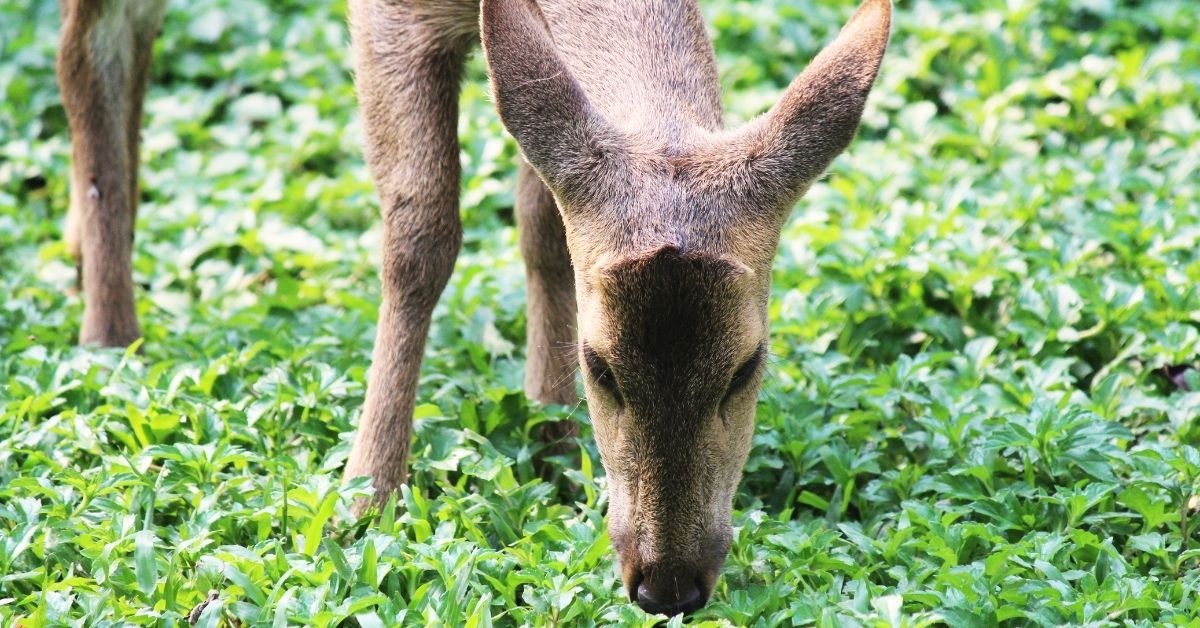
Change The Location of Plants
To be on the safe side, It’s always a better option to place the deer favor plants close to the house or in fenced-in areas. Not everybody has this amount of free space in the garden though
Plant Care
Tender, immature branches and buds are preferred by deer. In the fall, too much fertilizer spurs new growth at a time when other food sources are sparse.
15. Deer Resistant Plants
While no plant is 100 percent deer-proof, some are less likely to be damaged by deer than others. Deer will eat almost any plant, but they have definite preferences. You can reduce the risk of damage to your garden by growing flowers, trees, and shrubs that deer don’t favor.
In general, deer stays away from plants with thorns or prickly stems or leaves, plants with hairy leaves, plants that are poisonous, and plants with milky sap. They also tend to steer clear of plants with strong tastes or smells.
Following are two lists: plants deer rarely damage and plants deer commonly damage. Be aware that these lists vary significantly from one geographic area to another. And, if food is scarce, deer may browse plants they passed over in the past. If they are hungry enough, they will eat anything!
Plants Deer Rarely Damage
- Daffodils
- Ferns
- Pachysandra
- Rosemary
- Honeysuckle
- Lilac
- Potentilla
- Colorado Spruce
- Barberry
- Russian olive
- Common buckthorn
Plants Deer Commonly Damage
- Impatiens
- Tulips
- Daylily
- Fruit trees: Apple, crabapples, cherries, plums
- Birch
- Dogwood
- Hydrangea
- Linden
- Atlantic white cedar
- Redbud
16. Fruits And Vegetables That Deer Do Not Like
When keeping deer out of the yard, homeowners often assume that they must stop growing fruits and vegetables. Humans enjoy these, so why wouldn’t deer? Though it is true that deer do nibble on some of these, there are also some considered deer repellent plants and trees. Learning which ones are on a deer’s dislike list can make the vegetable and fruit garden come alive again.
Typically, deer-resistant plants, trees, and shrubs are categorized as rarely damaged, seldom severely damaged, occasionally severely damaged, and frequently severely damaged. Apple trees fall into the third category, meaning that starving deer may enjoy some of this crisp fruit. However, it is still a safe bet when considering what to include in a fruit garden.
Common pear trees fall into the same category as apples. A gardener may want to intersperse some bushes or shrubs that deer dislike. When thinking about other fruit trees to include, cross cherry and plum are off the list because deer frequently enjoy a snack from these. Deer also find strawberry plants quite delectable, so grow them inside.
Asparagus is one of the vegetables that deer will seldom touch. They also dislike onions, leeks, and garlic due to the strong smell. Squash is a vegetable enjoyed by many people but not by deer, so gardeners should feel free to include it in the yard. The globe artichoke is a deer deterrent vegetable due to its sharp foliage.
The growing selection may need to be expanded with foods that some people do not typically eat. Try persimmon, date palm, and edible figs because deer do not like these. Prickly pear is a vegetable that deer stay away from because of the thorns. Since super fruits are essential to our diet, grow some pomegranates. Deer do not like the sour taste, but many people enjoy it.
17. Hellebores On List Of New Deer Resistant Plants
Home gardeners are not content with the traditional plants and want the latest and greatest. They can usually find new additions each year, including deer repellent plants. There are three new hellebores in this category, and each is beautiful. These vigorous plants feature three to four-inch rounded flowers in eye-catching colors.
Hybridizing has expanded the color range of the hellebores. Slate gray, deep purple, plum, yellow, pink, green, and white are all included. As the flower ages, it turns greener, and individual flowers usually remain on the plant for at least one month.
Picotee flowers feature sepals in pale colorings with narrow margins containing a darker color. These are highly sought, as are plants featuring dark nectaries that contrast outer sepals.
These perennials have magnificent flowers that bloom for ten weeks, starting in late winter or early spring. The garden can look lovely while the neighbors are still collecting dead limbs and dry leaves because of the lengthy flowering season. When cut, the blossoms are stunning and may float in the water to make a charming centerpiece. Deer will not take a bite since the color saturation is great.
Over 125 grape-spotted blooms with plum-colored sepals and dark purple dots make up the Grape Galaxy variety.
Green Gambler features shamrock green flowers with red glitter specks and brilliant red picotee edges on some of them. The ruby-red blooms of Red Racer measure 3.5 inches across. Even the tiniest garden would seem opulent with these deer-resistant plants.
These cultivars are all part of the Winter Thriller line, and mature plants may produce over 150 flowers. Hellebores thrive on sand or heavy clay soil and grow best in hardiness zones four through nine. They have evergreen foliage that works well as a groundcover in the winter when the rest of the garden is bare.
18. Pretty Coreopsis Is A Deer-Repelling Machine
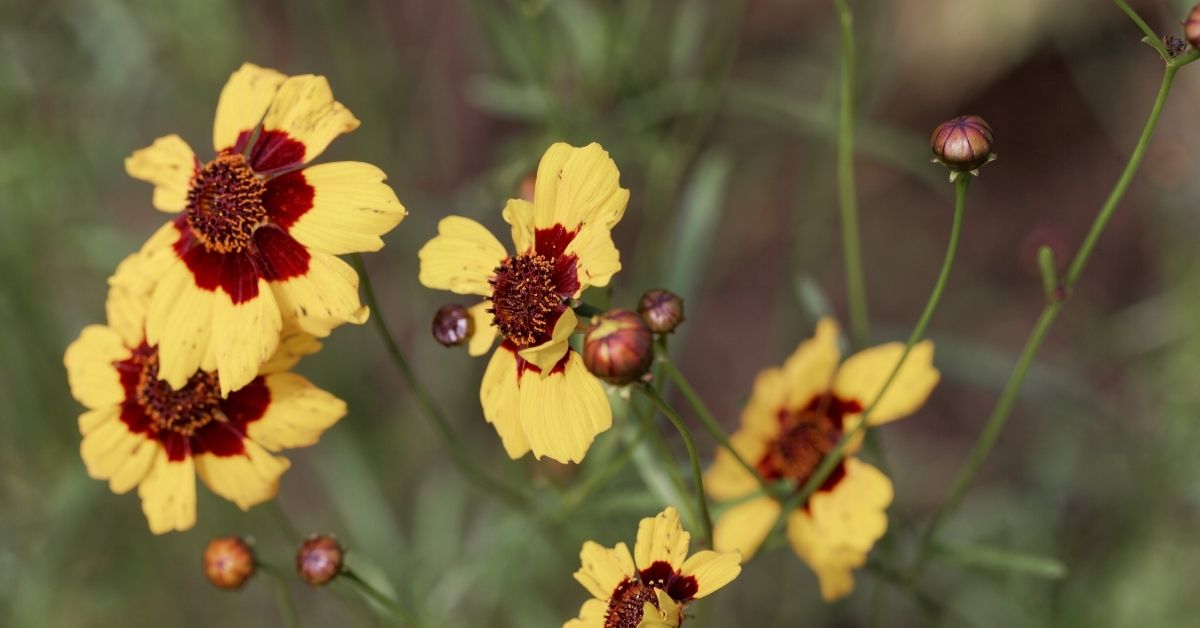
The perennial coreopsis is a pretty flowering plant with beautiful golden blooms. It is also an excellent deer repeller, making it a popular choice for gardeners who are fed up with deer munching in their yards. Threadleaf coreopsis is one of the rarely damaged deer-resistant plants, while lance coreopsis is seldom severely damaged.
Coreopsis is known for its long blooming season, which lasts throughout the summer and into the fall. Plants prosper in full sun, growing about 18 to 24 inches tall, though size varies by variety.
The Moonbeam species features tiny, yellow blossoms, and Zagreb is characterized by large flowers that are mustard-colored. Gardeners in northern climates often choose this second type because it is a hardier plant.
These cheery plants are perfect for use as borders and also look nice when cut and displayed within the home. They can be grown in temperature zones four through nine, and with so many kinds to choose from, gardeners have plenty of options. There are also species of C. rosea that have pink blooms with yellow centers. The red C. verticillata is one of the most recent additions.
These deer deterrent plants are often trouble-free and simple to cultivate and manage. They are, however, susceptible to fungal infections, slugs, and snails. Deadheading results in longer flowering; however, the plant might become a tangle because of the many flowers. Once the first rush of blossoms has faded, it is easy to prune back the entire plant.
Coreopsis is one of the best native wildflowers for incorporating into a garden, according to many gardeners. Gardeners will appreciate the deer-deterrent aspect of these well-formed plants, whether they choose a compact or spreading variety. Plants like delphinium, false indigo, and echinacea, as well as vertical plants like the daylily and allium, make excellent companions.
19. For Deer Resistance, Plant Attractive Ageratum in the Garden
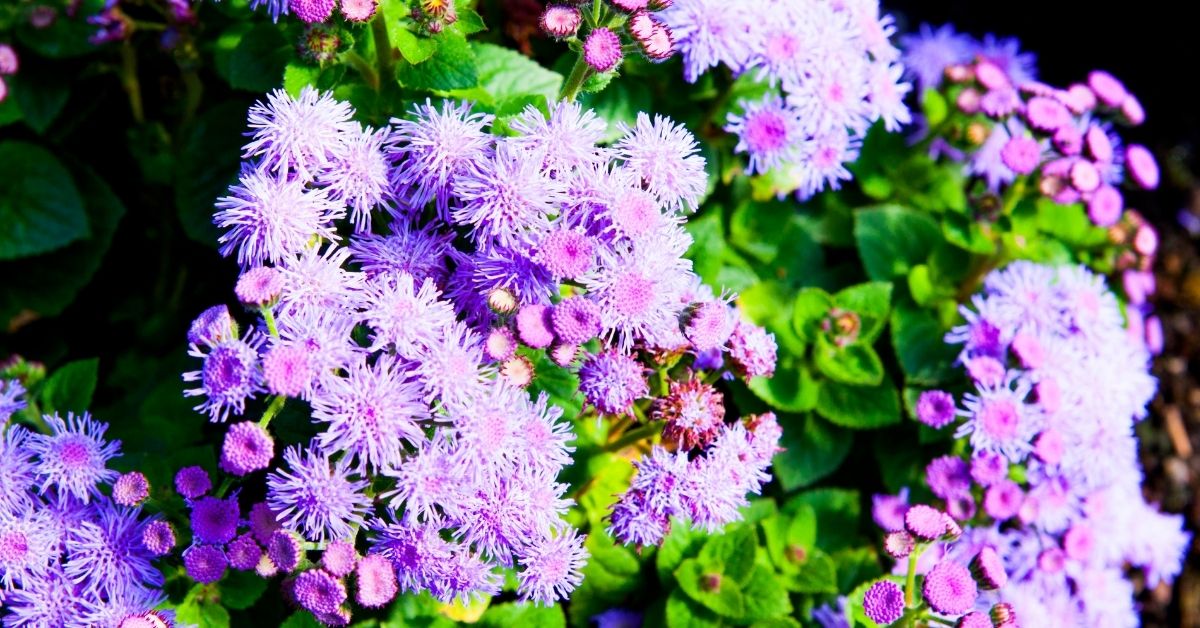
Ageratum is a beautiful, blooming perennial that deer rarely eat. Instead of eating this plant, the critters prefer to devour veggies and other flowers. Though ageratum is commonly chosen by gardeners in deer-prone locations since it is one of the most efficient deer deterrent plants, this annual is also incredibly attractive.
When cut and placed in a vase, the fluffy, blue blossoms of ageratum appear lovely. The most prevalent color is blue, but white, lavender, and pink can also be found. In tiny slopes, the plant grows to approximately six to eight inches tall, with oval, hairy leaves that form dense clusters. Taller varieties reach a height of around 18 inches.
Many gardeners use this plant as a border, in a rock or container garden, or as a bedding plant. When spaced nine to twelve inches apart, these deer-resistant plants thrive in moderate shade or full sun. Early summer is the start of the growing season, which lasts until the first frost. It’s a great plant for a newbie garden because it’s simple to cultivate.
When growing outside of its normal region, ageratum can become a weed in the environment. Because of the pyrrolizidine alkaloid concentration in certain species of this plant, gardeners with children should be cautious. Ageratum conyzoides and ageratum houstonianum have been linked to liver tumors and lesions. If consumed, the ageratum seed is toxic, and touching the plant can cause an allergic reaction or skin irritation.
The aromatic flowers attract birds, butterflies, and bees, and blooms will occur in late summer. Because this plant self-sows, it should be deadheaded if you don’t want seedlings next season. Allow the seeds to dry on the plant before removing them to sow in different regions the following year.
20. Beautiful, Deer Resistant Poppies For The Garden

Every garden can benefit from a bit of color, and poppies are just the flower to deliver it. Whether they are of the annual or perennial variety, flowering poppies feature four to six petals of nearly any color. Bees get their pollen from the stamens within the center of the flower, but deer generally leave these plants untouched, allowing them to burst into glorious color.
Deer-resistant plants like poppies are very versatile due to the many color varieties. Whether the gardener wants red, coral, pink, white, yellow, or purple, these will be easy to find. This is just a sampling of the colors available, allowing every side of the house to contain a different color scheme. If the gardener is undecided, these lovely plants can be grown in pots and relocated.
Plant height varies depending on species, ranging anywhere from 12 to 40 inches tall. These plants love full sun, perfect for those sun-filled gardens in which many other plants cannot survive. In general, plants should be placed between 12 and 18 inches apart, depending on the type. Poppies flourish in U.S. hardiness zones three through seven and are frequently sold in two or four-inch pots.
The papaver Orientale species of plant has flowers that look like crepe paper tulips. Even when deer nibble on the new foliage that appears in the fall, which they rarely do, brilliant flowers still appear during spring. The foliage is dormant by the end of June, so poppies should be planted among late-blooming, slow-starter plants.
Many deer repellent plants cannot claim to be as attractive as poppies. The “King Kong” variety is exceptionally breathtaking, growing an impressive 40 inches tall and featuring orange-red flowers. Gardeners can even find poppies featuring flowers with different colored borders, such as a red poppy with a white ring around the petals.
Conclusion: What do we recommend?
Given the scientific research and the experience of gardeners around the country, we recommend an integrated approach to protecting your plants from deer.
Deterrence starts with your garden plan. As much as possible, select plants that deer typically do not damage. For example, plant Norway spruce instead of Atlantic white cedar; daffodils instead of tulips. If you plant “deer-friendly” plants, keep them close to the house where deer is less likely to come.
Use contact repellents to protect vulnerable plants. Use area repellents to deter deer from sections of your garden. Experiment with different options and keep a record of what works and what does not work. Supplement your efforts with electronic devices for added control.
Consider a fence. Fences are expensive and may not fit in with every landscape, but they are often the only way to keep deer out.
Ask your neighbors and the local cooperative extension service for their suggestions about the best plants and effective deterrents for your location. Remember, there’s no one-size-fits-all approach to protecting your plants from deer when it comes to deer repellent.
